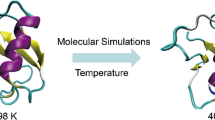Abstract
Autophagy is a versatile catabolic pathway for lysosomal degradation of cytoplasmic material. While the phenomenological and molecular characteristics of autophagic non-selective (bulk) decomposition have been investigated for decades, the focus of interest is increasingly shifting towards the selective mechanisms of autophagy. Both, selective as well as bulk autophagy critically depend on ubiquitin-like modifiers belonging to the Atg8 (autophagy-related 8) protein family. During evolution, Atg8 has diversified into eight different human genes. While all human homologues participate in the formation of autophagosomal membrane compartments, microtubule-associated protein light chain 3C (LC3C) additionally plays a unique role in selective autophagic clearance of intracellular pathogens (xenophagy), which relies on specific protein–protein recognition events mediated by conserved motifs. The sequence-specific 1H, 15N, and 13C resonance assignments presented here form the stepping stone to investigate the high-resolution structure and dynamics of LC3C and to delineate LC3C’s complex network of molecular interactions with the autophagic machinery by NMR spectroscopy.

Similar content being viewed by others
References
Cavanagh J, Fairbrother WJ, Palmer AG, Rance M, Skelton NJ (2007) Protein NMR spectroscopy, 2nd edn. Elsevier Academic Press, Burlington
Delaglio F, Grzesiek S, Vuister GW, Zhu G, Pfeifer J, Bax A (1995) NMRPipe: a multidimensional spectral processing system based on UNIX pipes. J Biomol NMR 6:277–293
He H, Dang Y, Dai F, Guo Z, Wu J, She X, Pei Y, Chen Y, Ling W, Wu C, Zhao S, Liu JO, Yu L (2003) Post-translational modifications of three members of the human MAP1LC3 family and detection of a novel type of modification for MAP1LC3B. J Biol Chem 278:29278–29287
Kouno T, Mizuguchi M, Tanida I, Ueno T, Kanematsu T, Mori Y, Shinoda H, Hirata M, Kominami E, Kawano K (2005) Solution structure of microtubule-associated protein light chain 3 and identification of its functional subdomains. J Biol Chem 280:24610–24617
Kovacs H, Gossert A (2014) Improved NMR experiments with 13C-isotropic mixing for assignment of aromatic and aliphatic side chains in labeled proteins. J Biomol NMR 58:101–112
Kumeta H, Watanabe M, Nakatogawa H, Yamaguchi M, Ogura K, Adachi W, Fujioka Y, Noda NN, Ohsumi Y, Inagaki F (2010) The NMR structure of the autophagy-related protein Atg8. J Biomol NMR 47:237–241
Noda NN, Ohsumi Y, Inagaki F (2010) Atg8-family interacting motif crucial for selective autophagy. FEBS Lett 584:1379–1385
Rogov VV, Suzuki H, Fiskin E, Wild P, Kniss A, Rozenknop A, Kato R, Kawasaki M, McEwan DG, Löhr F, Güntert P, Dikic I, Wakatsuki S, Dötsch V (2013) Structural basis for phosphorylation-triggered autophagic clearance of Salmonella. Biochem J 454:459–466
Rozenknop A, Rogov VV, Rogova NY, Löhr F, Güntert P, Dikic I, Dötsch V (2011) Characterization of the interaction of GABARAPL-1 with the LIR motif of NBR1. J Mol Biol 410:477–487
Sattler M, Schleucher J, Griesinger C (1999) Heteronuclear multidimensional NMR experiments for the structure determination of proteins in solution employing pulsed field gradients. Prog Nucl Magn Reson Spectrosc 34:93–158
Schwarten M, Stoldt M, Mohrlüder J, Willbold D (2010) Solution structure of Atg8 reveals conformational polymorphism of the N-terminal domain. Biochem Biophys Res Commun 395:426–431
Shpilka T, Weidberg H, Pietrokovski S, Elazar Z (2011) Atg8: an autophagy-related ubiquitin-like protein family. Genome Biol 12:226
Stangler T, Mayr LM, Willbold D (2002) Solution structure of human GABAA receptor-associated protein GABARAP: implications for biological function and its regulation. J Biol Chem 277:13363–13366
von Muhlinen N, Akutsu M, Ravenhill BJ, Foeglein A, Bloor S, Rutherford TJ, Freund SMV, Komander D, Randow F (2012) LC3C, bound selectively by a noncanonical LIR motif in NDP52, is required for antibacterial autophagy. Mol Cell 48:329–342
Vranken WF, Boucher W, Stevens TJ, Fogh RH, Pajon A, Llinas M, Ulrich EL, Markley JL, Ionides J, Laue ED (2005) The CCPN data model for NMR spectroscopy: development of a software pipeline. Proteins 59:687–696
Weiergräber OH, Mohrlüder J, Willbold D (2013) Atg8 family proteins—autophagy and beyond. In: Bailly Y (ed) Autophagy—a double-edged sword—cell survival or death? InTech, Rijeka, pp 13–45. doi:10.5772/55647
Author information
Authors and Affiliations
Corresponding author
Rights and permissions
About this article
Cite this article
Krichel, C., Weiergräber, O.H., Pavlidou, M. et al. Sequence-specific 1H, 15N, and 13C resonance assignments of the autophagy-related protein LC3C. Biomol NMR Assign 10, 41–43 (2016). https://doi.org/10.1007/s12104-015-9633-z
Received:
Accepted:
Published:
Issue Date:
DOI: https://doi.org/10.1007/s12104-015-9633-z




